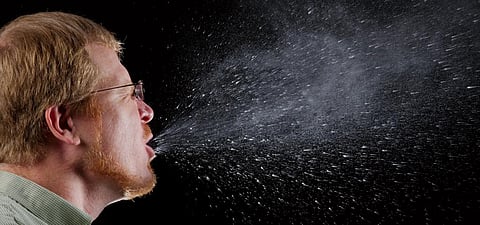

Many headlines screamed that the novel coronavirus or SARS-CoV-2 could be transmitted via air after July 7, 2020’s press conference held by the World Health Organization (WHO). But this is not true.
Recently, 241 scientists writing a letter to the United Nations (UN) health body, claiming they had evidence to prove that the novel coronavirus could be transmitted through air. WHO was asked this question at least twice in the press conference.
It did not say that it was accepting that this was, in fact, true. Rather, its officials present at the briefing said they had acknowledged the letter sent to the organisation and were looking into the ‘emerging evidence'.
“We acknowledge that there is emerging evidence in this field, as in all other fields regarding the novel coronavirus disease (COVID-19) virus and pandemic and therefore, we believe that we have to be open to this evidence,” said Benedetta Allegranzi, WHO’s infectious diseases lead.
This was definitely the first time the WHO was ready to look into the evidence of COVID-19 being airborne. On earlier occasions, it had categorically ruled this out. So far, the WHO’s stand has been that this disease can only have droplet transmission.
Allegranzi did not rule out the possibility of airborne transmision, especially in crowded settings. “These are fields of research that are really growing and for which, there is some evidence emerging but it is not definitive. Therefore, the possibility of airborne transmission in public settings, especially in very specific conditions — crowded, closed, poorly-ventilated settings that have been described — cannot be ruled out,” she said.
WHO experts were studying droplets of different sizes and trying to understand what the relative importance of this was, Allegranzi, said. They were also trying to understand the dose of the virus that was needed in this route — aerosol or airborne — of transmission, she added.
Droplet vs airborne
‘Droplet spread’ refers to spray with relatively large, short-range aerosols produced by sneezing, coughing, or even talking, according to the United States Centres for Disease Control and Prevention (CDC). Droplet spread is classified as direct because transmission is by direct spray over a few feet, before the droplets fall to the ground.
On the other hand, airborne transmission occurs when infectious agents are carried by dust or droplet nuclei suspended in air. Droplet nuclei are dried residue of less than five microns in size while droplets causing droplet transmission are relatively bigger.
In contrast to droplets (causing droplet transmission) that fall to the ground within a few feet, droplet nuclei (causing airborne transmission) may remain suspended in the air for long periods of time and may be blown over great distances.
Other modes
Maria Van Kerkhove, the WHO’s technical lead on the COVID-19 pandemic said, “We have been talking about the possibility of airborne transmission and aerosol transmission as one of the modes of transmission of COVID-19 as well as droplet. We’ve looked at fomites, faecal-oral, mother-to-child and animal-to-human as well.”
She said a brief on this would be issued soon by the WHO. “But we’re also looking at the possible role of airborne transmission in other settings, particularly close settings where you have poor ventilation. So, we will be issuing our brief in the coming days and that will outline everything that we have in this area,” Kerkhove said.
However, WHO scientists highlighted that all precautions, whatever the mode of transmission need to be followed. “This includes not only physical distancing; it includes the use of masks where appropriate in certain settings, specifically when you can’t do physical distancing and especially for health workers,” WHO Chief Scientist Soumya Swaminathan, said.
“We do recommend appropriate and optimal ventilation of indoor environments and also physical distancing, as you know. When this is not possible in areas with community transmission of the virus, we recommend the use of face masks, in particular fabric, non-medical masks for the public,” Swaminathan noted.
She added, “You have to take ecologically descriptive data sometimes from outbreaks that happen in different settings which may point in a certain direction but then, you cannot always rule out... For example, it may point to the fact that there could have been limited airborne transmission. But it could also be through fomites or other means and so the body of evidence continues to grow and we adapt and so we do what’s called a living systematic review.”